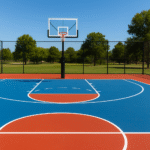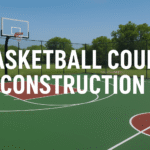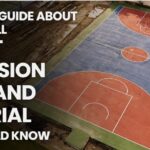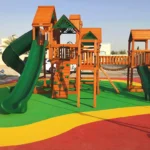Introduction to Sports Court Flooring Construction
Building a sports court isn’t just about leveling the ground and painting lines. The flooring plays a huge role in how athletes perform and stay safe. Whether it’s basketball, tennis, badminton, or futsal, the type of flooring used determines comfort, durability, and performance.
Why Sports Court Flooring Matters
Safety and Performance
Proper flooring reduces the risk of injuries by absorbing impact and providing slip resistance. Athletes can run, jump, and change direction confidently.
Longevity and Durability
Good flooring withstands heavy usage, weather, and wear, lasting for years without frequent replacements.
Types of Sports Courts
- Indoor Courts – Designed for sports like basketball, volleyball, and badminton. These courts often use wooden or vinyl surfaces.
- Outdoor Courts – Built for tennis, futsal, or multi-sports, these surfaces must resist weather conditions.
Popular Sports Flooring Options
Wooden Flooring
Classic choice for basketball and badminton courts. Offers excellent bounce and professional feel.
Synthetic Flooring
Versatile and cost-effective, suitable for multi-purpose courts.
Acrylic Surfaces
Common for tennis courts. Provides grip, UV resistance, and weather durability.
Polyurethane (PU) Flooring
Seamless and durable, used in indoor multipurpose arenas.
EPDM Rubber Flooring
Shock-absorbent, slip-resistant, and ideal for both indoor and outdoor use.
PVC Vinyl Flooring
Affordable, easy to maintain, and widely used for indoor courts.
Clay and Grass Surfaces
Popular for tennis courts, offering a traditional playing experience.
Step-by-Step Sports Court Construction Process
1. Site Inspection and Planning
A detailed survey ensures correct measurements, drainage, and base stability.
2. Groundwork and Base Preparation
Excavation, leveling, and installation of a strong foundation like concrete or asphalt.
3. Surface Installation
Laying the chosen flooring material—wood, synthetic, or acrylic—based on sport requirements.
4. Markings and Court Lines
Professional painting ensures accuracy in dimensions and sport-specific rules.
5. Finishing Touches
Lighting, fencing, and additional accessories complete the court.
Factors to Consider Before Choosing Flooring
- Sport-Specific Needs: Basketball demands bounce, while tennis needs grip.
- Climate Conditions: Outdoor courts need weather-resistant surfaces.
- Budget and Maintenance: Wooden courts cost more but add prestige, while vinyl is cheaper and easy to maintain.
Indoor vs Outdoor Court Flooring
- Indoor Courts: Favor wood, vinyl, or PU surfaces.
- Outdoor Courts: Acrylic, synthetic, or rubber flooring is preferred for weather durability.
Cost of Sports Court Flooring Construction
Costs vary widely depending on material, size, and location. For example:
- Wooden court: Higher investment but long-lasting.
- Acrylic surface: Moderate cost with low maintenance.
- Vinyl/PVC: Budget-friendly option.
Maintenance Tips for Longevity
- Regular Cleaning: Prevent dust and dirt buildup.
- Repair and Refurbishment: Fix cracks and repaint lines on time.
- Seasonal Care: Cover outdoor courts during harsh weather.
Eco-Friendly Flooring Solutions
Modern flooring solutions now include recycled rubber, non-toxic adhesives, and sustainable woods. These reduce environmental impact while maintaining quality.
Mistakes to Avoid During Construction
- Ignoring ground leveling
- Choosing the wrong material for climate
- Poor line marking and finishing
- Hiring inexperienced contractors
Benefits of Professional Installation
Professionals ensure precision, durability, and compliance with international standards. This saves money and time in the long run.
Latest Trends in Sports Court Flooring
- Smart flooring with shock sensors
- Modular flooring tiles
- Eco-friendly materials
- Customized multi-sport courts
Case Study: Successful Sports Court Projects
A multi-sport facility in India used acrylic flooring with LED lighting and fencing. The result: a durable, low-maintenance court that attracts athletes year-round.
Conclusion
Sports court flooring construction is more than just a surface—it’s the foundation of every game. The right flooring ensures performance, safety, and durability. Whether for professional or recreational use, investing in quality materials and professional installation pays off in the long run.
FAQs
1. What is the best flooring for a basketball court?
Wooden flooring is considered the best due to its bounce and professional finish.
2. Can outdoor courts use wooden flooring?
Not recommended, as wood doesn’t handle weather well. Acrylic or synthetic flooring is better.
3. How long does a sports court last?
With proper care, 10–20 years depending on the material.
4. Is synthetic flooring better than vinyl?
Synthetic is more versatile, while vinyl is cost-effective and good for indoor use.
5. How much does it cost to build a standard badminton court?
It depends on the flooring material, but typically ranges between moderate to high investment based on choice.




